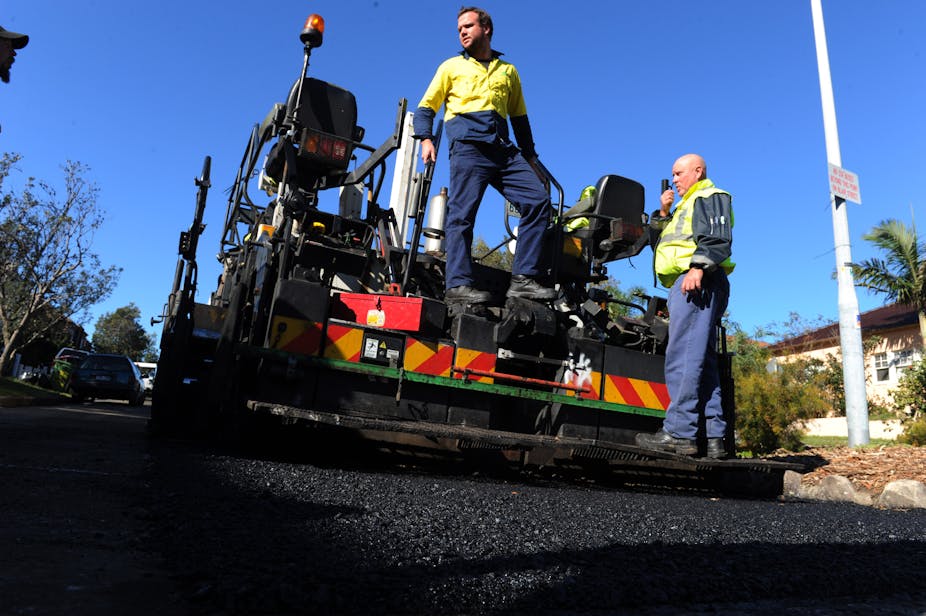Pity the humble transport researcher who tries to understand how much Australian governments spend on roads and public transport! In this country, figuring out who gets most is next to impossible.
The Bureau of Infrastructure, Transport and Regional Economics (BITRE) gives us some helpful data on construction expenditure, which shows what most transport analysts broadly understand: that road gets far more than public transport.
BITRE also publishes data on government road expenditure, which equals road construction expenditure. What happened to maintenance? Too hard to separate out?
The picture is no clearer for public transport. The Australian Conservation Foundation’s recent publication, Australia’s Public Transport: Investment for a Clean Transport Future, draws on BITRE data, and adds a bit for Federal Government assistance through the fuel tax credit and Fringe Benefits Tax.
In its website reporting on its research, ACF concludes that “…the amount of money spent on construction work by all levels of Australian governments on public roads and bridges has been 4.3 times…that spent on public railway construction.”
This is probably in the right ballpark but it considerably understates government support for public transport.
Support for public transport moves in mysterious ways
Most government support for public transport is not construction but operational support, to cover the gap between fares and costs of running the service. This is not easy to identify, State Budget papers being masters of obfuscation.
However, by way of example, the 2010-11 Victorian Budget Paper No. 3 suggests that the State expected to provide $1.7b to train, tram and bus operators for metropolitan public transport services (which includes a reimbursement of fare revenue to operators, so is not all net cost to government), $0.4b to regional public transport service operators and $0.25b for specialist services. These total $2.4b.
Public transport infrastructure development was provided with a small $143 million. The Budget papers suggest that the Total Output Cost for public transport was expected to be $3.8b, so there is something over $1b unexplained. Goes to explain the number of bald transport analysts!
What is the point of all these numbers? My conclusion is that government spending on roads, as compared to public transport, is not nearly as weighted in favour of roads as the ACF concludes, once service operating assistance is included.
In States like NSW and Victoria, the funding to roads and public transport, in total, is probably pretty nearly equal – if it could ever be deciphered!
More than you think, but nowhere near enough
It does not do justice to the ACF’s research, however, to quibble about such numbers. The ACF’s main message is important: Australian governments must do more to upgrade our public transport systems to deal with several critical national problems:
• The congestion costs in our cities are high ($10b annually) and rising, reducing economic competitiveness and liveability.
• Road transport greenhouse gas emissions are high and growing quickly.
• Transport/land use systems contribute to social exclusion and little progress is being made to tackle this problem.
• Our road toll remains unacceptable, with serious injuries rising markedly and fatalities remaining at about 1450 or more annually.
• Obesity is increasing (partly due to more sedentary lifestyles).
• Energy security is diminishing.
How will we fuel all those cars?
The ACF’s focus on energy security issues is particularly welcome. Australia is currently about 50% self-sufficient for oil but the Foundation points out that imports are likely to rise to about 70% by 2015.
There has been inadequate national attention to the possible consequences of declining domestic supplies and, in particular, attention on how to manage possible extended supply disruptions.
The European Commission’s new transport White Paper, Roadmap to a Single European Transport Area, gives energy security a central role. Australia needs to show greater concern in this area.
The consequences of high and rising oil prices for outer urban and regional residents are more widely recognised but again given inadequate policy attention in Australia.
The outer suburbs are where many first home buyers look for houses that are relatively more affordable. High fuel prices mean that savings on property prices can be quickly lost in higher transport costs, which are likely to grow over time. Risks of social exclusion increase in this setting.
Will somebody please think of the freight?
The ACF is right. Australian governments need to spend more on public transport. But this should not mean less spending on roads in absolute terms.
The main reason why road spending will need to be sustained is the growing demand for freight movement. This is growing far more quickly than our rate of economic growth.
This is partly because we do not price road use properly. If all road users were confronted with meeting the costs their travel choices impose on the wider community, traffic levels would fall, including road freight volumes.
In the meantime, much closer attention needs to be paid to road needs for freight movement, with greater focus on separate facilities that are paid for by freight users.
Public transport needs roads too
The other reason for sustaining road expenditure is that much public transport (buses and trams) runs on roads. This transport needs more road space.
Brisbane is a world leader in Bus Rapid Transit and other cities need to draw from their example. Providing separate right-of-way for road-based public transport is an important complement to better rail facilities. With better rail, and better buses and trams, more people will use public transport.

